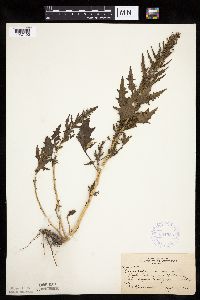Oxybasis rubra
|
|
|
|
Family: Amaranthaceae
Red Eurasian-Goosefoot, more...red goosefoot
[Blitum maritimum Nutt., moreChenopodium patulum Mérat, Chenopodium rubrum L., Chenopodium succosum A. Nelson] |
Stems erect to ascending or prostrate, much-branched, 0.1-6(-8) dm, glabrous. Leaves non-aromatic; petiole 0.05-0.45 cm; blade triangular to rhombic, 1-9 × 1-6 cm, base cuneate, margins dentate or entire, apex obtuse to acute. Inflorescences lateral glomerules sessile on lateral branched spikes; glomerules subglobose, 2-5 mm diam.; bracts linear, 0.4-2 cm. Flowers: perianth segments 3 or 4, usually connate only at base; lobes lanceolate to elliptic, 0.8-1 × 0.4-0.8 mm, membranaceous, apex broadly acute to rounded, occasionally deeply retuse, rounded or occasionally keeled, glabrous, green and covering fruit at maturity; stamens 2-3; stigmas 2, 0.1 mm. Utricles ovoid; pericarp nonadherent, reticulate-punctate. Seeds vertical and occasionally horizontal, ovoid, 0.6-1(-1.2) mm diam., margins rounded; seed coat reddish brown, smooth. 2n = 18. Annual herb 10 cm - 0.8 m tall Stem: prostrate or upright to ascending, much-branched. Leaves: alternate, on a 0.5 - 4.5 mm long stalk, often tinged red or becoming red with age, 1 - 10 cm long, 1 - 6 cm wide, triangular to diamond-shaped with a tapering base and blunt to pointed tip, sometimes toothed, having a conspicuous lateral tooth on each side. Inflorescence: a 2 - 5 mm wide, stalkless, nearly round cluster of flowers (glomerule), which together form lateral, branched spikes. Flowers: greenish, often tinged red, small, with three or four nearly distinct sepals and no petals. Sepal lobes about 1 mm long, lance-shaped to elliptic with a rounded to broadly pointed apex, sometimes keeled. Stamens two to three. Stigmas two. Fruit: one-seeded (utricle), enclosed in the persistent, incurved sepals, egg-shaped, thin-walled. Wall (pericarp) not adherent to the seed, wrinkled-dotted. Seed vertical, sometimes horizontal, reddish brown, shiny, 0.6 - 1 mm wide, egg-shaped, round-margined, smooth. Similar species: No information at this time. Flowering: July to October Habitat and ecology: Introduced from farther west. Rare in the Chicago Region. Typically found in disturbed soil. Occurence in the Chicago region: non-native Etymology: Chenopodium comes from the Greek words chen, meaning goose, and podion, meaning "little foot," referring to the leaf shape of some species. Rubrum means red. Author: The Morton Arboretum FNA 2004, Heil et al 2013, McDougall 1973, Welsh et al 1987, Kearney and Peebles 1979 Duration: Annual Nativity: Native Lifeform: Forb/Herb General: Herbaceous annuals, 20-60 (100) cm tall; stems stout and erect with steeply ascending branches; herbage mostly glabrous but can be somewhat villous in the inflorescence; plants turn anthocyanic (change to a red color as they die) in the autumn. Leaves: Alternate and short-petiolate, the petioles to 0.5 cm; blades triangular to rhombic, 1-9 cm long, one-half to two-thirds as long as wide, with a cuneate to subhastate base, margins usually dentate or lobed but sometimes entire, often suffused with red. Flowers: Inconspicuous, green, and clustered, the clusters (glomerules) arranged in sessile spicate panicles, both axillary and terminal. Flowers glabrous to sparsely powdery or villous; perianth segments, 3-4, red to green, the lobes cleft to below the middle. Fruits: Utricle ovoid, the pericarp not adherent; seeds 1 mm, vertical and occasionally horizontal, ovoid, with rounded margins; seed coat reddish brown, smooth. Ecology: Found in open, saline places, drying mudflats and old fields; elevation range in the Southwest is 4,000- 9,000 ft (1219-2743 m); flowers June-September. Distribution: Widespread in the U.S., Canada, and Eurasia. Notes: Chenopodium is a genus of usually weedy annual herbs with simple, alternate leaves, herbage that is commonly farinose (with mealy, or floury hairs) to some degree, and clusters of small green flowers lacking petals, which mature into fruits composed of a single seed wrapped in the persistent calyx. C. rubrum is nearly impossible to distinguish from the introduced C. murale. The primary difference between the two species is the orientation of the seeds, which are horizontal in C. murale and vertical in C. rubrum. However, C. murale is common in Arizona, particularly below the Mogollon Rim, and is rarely known from New Mexico, while C. rubrum is more common in New Mexico and rarely occurs in Arizona. Also resembles C. capitatum, which has a bright red calyx in fruit. However, the fruit of C. capitatum becomes fleshy upon maturity, hence its common name -strawberry spinach.- C. rubrum is fire intolerant and has low browse and graze potential. Ethnobotany: Seeds are staple in Gosiute diet. Etymology: Chenopodium means goose foot, while rubrum means red. Synonyms: None Editor: SBuckley 2010; AHazelton 2015 Annual, branched from the base, prostrate to erect, 1-8 dm, the foliage and fls commonly tinged with red or becoming red at maturity; lvs commonly rhombic-ovate or oblong, with a conspicuous lateral tooth on each side, cuneate below the teeth, varying to entire or several- toothed, green on both sides; fls in ±numerous glomerules, these to ca 5 mm thick at maturity, in small plants chiefly axillary, in larger ones aggregated into terminal paniculiform infls; sep mostly 3; seeds erect, shiny dark brown, lenticular, 0.6-1 mm wide; 2n=36. Salt marshes and brackish soil, Nf. to N.J.; more abundant inland, from Ind. and Io. to Wash. and Calif., and occasionally adventive elsewhere. Tall, erect plants with lvs 4-10 cm and large infls are typical C. rubrum. Prostrate plants with small lvs and only axillary glomerules have been segregated on insufficient grounds as C. humile Hook. or C. rubrum var. humile (Hook.) S. Wats. Gleason, Henry A. & Cronquist, Arthur J. 1991. Manual of vascular plants of northeastern United States and adjacent Canada. lxxv + 910 pp. ©The New York Botanical Garden. All rights reserved. Used by permission. |




























































































